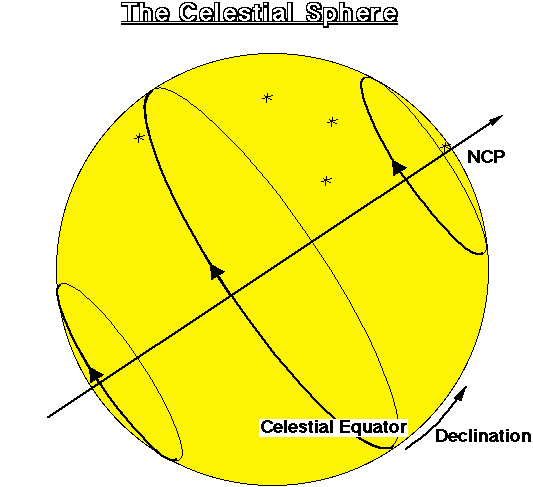
1. Celestial Sphere with "fixed" stars
A) Orientation on Earth and sky
| Parallel: | lines parallel to the equator |
| (Durham on 43th parallel, 43o north of equator) | |
| stars apparently move along parallels over the sky |
| Meridian: | lines from south pole to north pole |
| line from south overhead to north |
We use the same lines on Earth and projected onto the sky
| Earth (Globe) | Sky (Celestial Sphere) |
| Poles (N, S) | Celestial Poles (N, S) |
| Equator | Celestial Equator |
| Parallels | Paralles |
| Latitude | Declination |
| Meridian (local N-S line) | Meridian (dto.) |
| Longitude | Right Ascension |
B) Coordinates in the sky:
a)
| North Celestial Pole (NCP) | (always above horizon in Durham). |
| South Celestial Pole | (always below horizon in Durham). |
| Celestial Equator | (only 1 half above the horizon) |
b) Declination: degrees N or S of celestial equator (like being on a certain Parallel)
c) NCP at 90o N of equator

2. Apparent rotation of the sky from East to West
(Earth turns W to E = counterclockwise, when we look down onto Northern Hemisphere)
A) How do stars on certain positions move over the sky?

B) Sidereal day
3. Sun.
A) Apparent annual eastward motion with respect to the stars.
Observed by:
a) Solar day (noon to noon) is longer than sidereal day.


Eastward motion of sun is due to:
b) Westward progression of constellations in the sky during year:
After some time a constellation which is east of the previous one is seen at the same position in the sky, when observing at the same time of the night.
Sun's motion across the sky completed after 1 year
B) Change in declination during year:
Observed by:Change of
These values are different for different latitudes on Earth!
| Dec. 22 | decl. = -23 1/2 deg. | winter solstice |
| March 20 | decl. = 0, vernal equinox | |
| June 22 | decl. = +23 1/2 deg. | summer solstice |
| Sept. 23 | decl. = 0, autumnal equinox | |
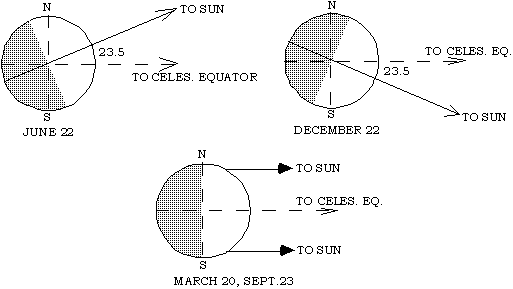
C) Ecliptic: apparent annual path of sun with respect to the stars.
The ecliptic:
Due to:
(does not prove the earth goes around the sun)
Leads to Seasons:
Leads to Climates:
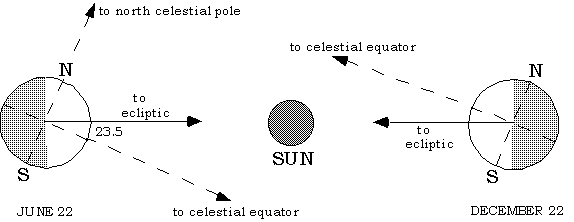
D) Sun clock is not exact over the year (called Analemma)
Solar day not exactly 24h (varies over the year) but annual average very close to 24h
This is due to:
4. Moon
A) Apparent motion of the Moon
a) Eastward with respect to sun and stars
Due to:
b) Phases: Sunlit side 'points' toward sun.

Crescent moon close to sun:
Full moon opposite to sun:
Boundary between light and dark on the moon is an arc
Half moon at right angle to the sun in the sky
Earthshine observed on new moon and crescent
c) Synodic month (refers to phases)
Synodic month originally used as definition of Month
From month to month each phase (e.g. full) of the moon progresses eastward through the stars.
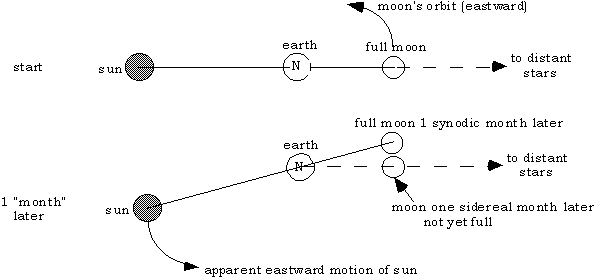
B) Moon's orbit
Moon's orbit inclined 5 degrees to ecliptic

Due to:
b) Nodes progress westward
Due to:
C) Eclipses
Reason:
But not every new or full moon, only when new or full moon near ecliptic (i.e. node).
Eclipse seasons:
a) Lunar Eclipses:
Types:
But: moon not completely dark during total eclipse
Uses of lunar eclipses:
b) Solar Eclipses:
Types:
Uses of full eclipses:
| Study solar atmosphere | in Chapter VIII |
We see: sunlight scattered by electrons & dust
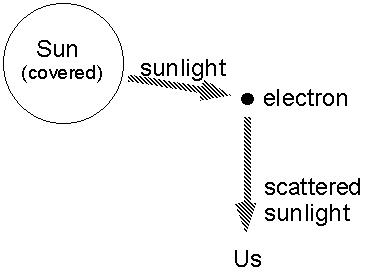
- General Relativityin Chapter X
(Bending of starlight by gravitational forces)
5. Calendar
Based on:
| A)Sun | day | (one circle over the sky) |
| year | (journey along the ecliptic) = 365.24 days | |
| B)Moon | month | (m6; one full cycle of lunar phases) |
| sidereal month m6; 28 days | Synodic month m6; 29.5 days |
All "wandering" objects in the sky (as known in ancient times)
Symbolic association with days
| Sunday | Sun |
| Monday | Moon |
| Tuesday | Mars (Mardi in French) |
| Wednesday | Mercury (Mercredi in French) |
| Thursday | Jupiter(= Thor in Germanic heaven) |
| Friday | Venus(= Freya " ) |
| Saturday | Saturn |
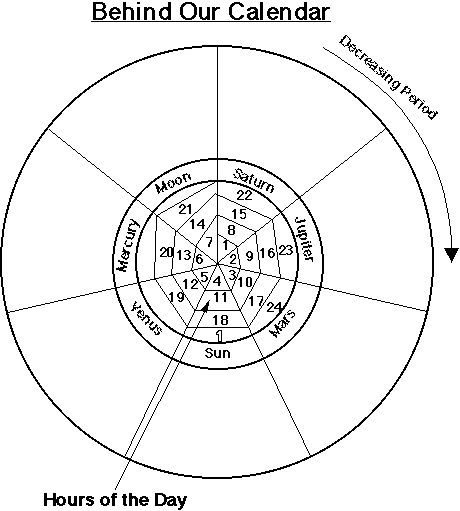
6. Planets
Apparent motion of the planets with respect to the sun and stars.
A) Appear to move through the stars on nearly great circles close to the ecliptic
Due to:
| Mercury, Venus always | appear close to sun | (inferior planets) |
| Mars, Jupiter, Saturn can | appear far from sun | (superior planets) |
B) Mercury, Venus
We can see them either right before sunrise or right after sunset:

We define:

Best time to see Mercury: At maximum Elongation, in particular: in Spring after sunset or in Fall before sunrise
C) Mars, Jupiter, Saturn.

We define:
Best time to observe:
Winter opposition best:
(The constellations of the Zodiac are high in the sky on winter nights and low in the sky on summer nights.)

Apparent motion of Mars, Jupiter, and Saturn, is eastward with respect to stars except near opposition
--- The motion at opposition is called "Retrograde":
Apparent westward motion with respect to stars as Earth speeds by the planet
(Planets draw loops in the sky with respect to the stars)
After one Earth year the planet appears further east with respect to the stars:
Due to: